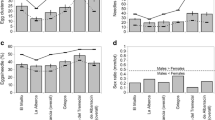Abstract
An investigation on the behaviour ofTetrastichus servadeii Domenichini (Hym.: Eulophidae) andOoencyrtus pityocampae Mercet (Hym.: Encyrtidae) was carried out in 2 stands ofPinus nigra Arnold in the Venitian Prealps (NE Italy) by quantitative observations in the field and by trapping with different baits. The results indicate that: 1)O.pityocampae is caught by traps baited with pityolure, the synthetic sex pheromone of the host, whileT. servadeii was never caught. 2) The host selection process ofT. servadeii seems to be associated with the host plant ofThaumetopoea pityocampa (Denis & Schiffermüller) and with the aggregative behaviour of the parasitoid females. 3) The frequency distribution ofT. servadeii on the egg masses follows the negative binomial distribution; the degree of aggregation decreases with the egg mass age. These results may be taken into account in the utilization of egg parasitoids for the biological control ofTh. pityocampa.
Résumé
Les recherches sur le comportement deTetrasticus servadeii Domenichini [Hym.: Eulophidae] et deOoencyrtus pityocampae Mercet (Hym.: Encyrtidae) ont été effectuées dans 2 peuplements dePinus nigra Arnold des Prealpes Vénitiennes (Italie du Nord-Est).
La méthode d'étude a consisté en observations quantitatives dans la nature et en piégeage avec différents appâts. Les résultats montrent que: 1)O. pityocampae est capturé par les pièges à phéromone sexuelle deTh. pityocampa, tandis qu'il est peu attiré par d'autres pièges (♂♂ et ♀♀ adultes deTh. pityocampa, pontes fraîches). D'autre part,T. servadeii n'est jamais capturé par aucun piège. 2) ChezT. servadeii la recherche des pontes semble être associée à la plante hôte deTh. pityocampa et au comportement agrégatif des ♀♀ du parasitoïde. 3) La distribution de fréquence deT. servadeii sur les pontes suit le modèle de la distribution binomiale négative; le degré d'agrégation diminue au fur et à mesure que les pontes vieillissent.
Les stratégies de recherche de l'hôte chez les 2 parasitoïdes oophages suggèrent que leur efficacité dans le contrôle naturel deTh. pityocampa peut varier selon la densité de population de l'hôte et les conditions du peuplement forestier (T. servadeii est favorisé par une haute densité de population de l'hôte,O. pityocampae par une faible densité de population de l'hôte). Ces faits doivent être considérés dans les programmes de lutte biologique contreTh. pityocampa avec les parasitoïdes oophages.
Similar content being viewed by others
References
Bargoni, V., Capizzi, A. &Marcuccetti, G. — 1983. Processionaria del pino: nuove prospettive di lotta. —Economia Montana, 15, 47–51.
Battisti, A. — 1986. Ricerche bio-ecologiche e demografiche suThaumetopoea pityocampa (Denis & Schiffermüller) in pinete diPinus nigra Arnold delle Prealpi orientali. —Tesi di dottorato, Bologna, p. 78.
Biliotti, E. — 1958. Les parasites et prédateurs deThaumetopoea pityocampa Schiff. [Lepidoptera]. —Entomophaga, 3, 23–34.
Bliss, C. I. &Fisher, R. A. — 1953. Fitting the negative binomial distribution to biological data and note on the efficient fitting of the negative binomial. —Biometrics, 9, 176–200.
Demolin, G. — 1969. Comportement des adultes deThaumetopoea pityocampa Schiff. Dispersion spatiale, importance écologique. —Ann. Sci. For., 26, 81–102.
Geri, C. — 1980. Application des méthodes d'études demécologiques aux insectes défoliateurs forestiers. Cas deDiprion pini L. [Hym.: Diprionidae]. Dynamique des populations de la processionnaire du pinThaumetopoea pityocampa Schiff. [Lep.: Thaumetopoeidae] dans l'île de Corse. —Thèse Doct.-Sci., Paris Sud, Orsay, 249 + XIV.
Girolami, V. &Mozzi, A. — 1983. Distribution, economic threshold and sampling methods ofPanonychus ulmi (Koch). In: Statistical and Mathematical Methods in Population Dynamics and Pest Control (R. Cavalloro, ed.). —Balkema, Rotterdam/Boston, 90–101.
Halperin, J. — 1985. Mating disruption of the Pine Processionary Caterpillar by Pityolure. —Phytoparasitica, 13, 221–224.
Kailidis, D. S. — 1962a. Bemerkungen überThaumetopoea pityocampa Schiff. und seine Feinde in Griechenland. —Z. Angew. Entomol., 51, 182–187.
Kailidis, D. S. — 1962b. Bemerkungen über die EiparasitenOoencyrtus pityocampae Mercet undTetrastichus sp. vonThaumetopoea pityocampa in Griechenland. —Anz. Für Schädlkde, 35, 119–122.
Lewis, W. J., Snow, J. W. &Jones, R. L. — 1971. A Pheromone Trap for Studying Populations ofCardiochiles nigriceps, a Parasite ofHeliothis virescens. —J. Econ. Entomol., 64, 1417–1421.
Masutti, L. — 1964. Ricerche sui parassiti oofagi dellaThaumetopoea pityocampa Schiff. —Ann. Centro Econ. Mont. Ven., 4, 205–271.
Masutti, L. — 1966. Comportamento dei Calcidoidei oofagi. —Atti VI Congr. Naz. It. Entomol., 45–73.
Mercet, R. G. — 1932. Los parastos de los insectos perjudiciales. —Salvat, Barcelona, pp. VII+151.
Tiberi, R. — 1978. Notizie preliminari sull'incidenza dei parassiti oofagi nelle popolazioni di processionaria del pino in giovani pinete dell'Italia Centrale. —Redia, 61, 487–501.
Tiberi, R. — 1980. Modificazioni della distribuzione dei parassiti oofagi in ovature diThaumetopoea pityocampa, conseguenti al potenziamento artificiale diTetrastichus servadeii Dom. —Redia, 63, 307–321.
Tiberi, R. — 1984. Ospite vegetale, numero di ovature, luoghi di ovideposizione e loro influenza sull'attivita' dei parassitoidi oofagi diThaumetopoea pityocampa [Hym.: Chalcidoidea]. —Redia, 67, 1–18.
Tzankov, G. — 1972. On the biology and ecology of pine procession moth [Thaumetopoea pityocampa Schiff.] egg-eaters in Bulgaria. —Proc. XIII Int. Congr. Entomol., Moscow 1968, 3, 102.
Vinson, S. B. — 1976. Host selection by insect parasitoids. —Annu. Rev. Entomol., 2, 109–133.
Vinson, S. B. — 1985. The Behaviour of Parasitoids. In: Comprehensive insect physiology biochemistry and pharmacology (G. A. Kerkut &L. I. Gilbert, eds.). —Pergamon, Oxford, 9, 417–470.
Author information
Authors and Affiliations
Rights and permissions
About this article
Cite this article
Battisti, A. Field studies on the behaviour of two egg parasitoids of the pine processionary mothThaumetopoea pityocampa . Entomophaga 34, 29–38 (1989). https://doi.org/10.1007/BF02372584
Received:
Accepted:
Issue Date:
DOI: https://doi.org/10.1007/BF02372584



